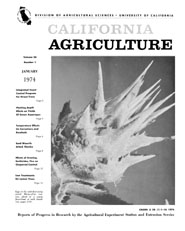|
|||
|
|||

Cover:
Eggs of the seed-destroying weevil, Rhinocyllus conicus, glued to a young flowerhead of milk thistle.
January 1974
Volume 28, Number 1 News and opinion |
|||
|
University of California, 1301 S. 46th St., Bldg. 478 Richmond, CA
|